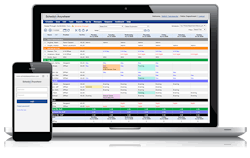How Two PDs Improved Efficiency by Updating Their Scheduling Methods
Content provided by ScheduleAnywhere
When it comes to law enforcement, partnerships are paramount. Whether it’s the pairing of an officer with his K-9, or the alliance between an agency and the community it serves, partnerships are the cornerstone of an effective public safety facility. But what about the partnerships we don’t typically consider? The ones that occur behind the front lines, such as finding the right officer scheduling method to meet the specific requirements of each facility and its departments.
This partnership can mean the difference between an efficient operation and one that spends far too much time on staffing issues. That’s what 35-year police veteran Chief Jeffrey Beahen, of the Rogers Minn. Police Department discovered after struggling to manage his staff’s intricate schedules.
“For years, our department manually wrote out the employee schedule on paper and posted it in the office. We tried to create a yearly schedule, but it took us days to complete.” Beahen said. “And then there were the added issues of personnel and shift changes, time-off requests and variances in manpower demands.”
Beahen was not alone in his scheduling frustrations. On the other side of the country, a police department in California was experiencing similar challenges.
“We were creating our schedules in an Excel spreadsheet,” said Elva Valasek, Dispatcher II, who co-manages scheduling duties at the Folsom Police Department. “It just took so much of our time; we had to manually count how many officers we had to ensure adequate coverage for each shift.”
Beahen and Valasek knew there had to be a better solution, and each set out in search of an alternative scheduling system. Both police departments knew they wanted an online, cost-effective program that would work with their unique scheduling demands. Folsom is a full-service police department of 75 sworn officers and 27 professional staff members. The Rogers police department employs 18 full-time licensed peace officers and four professional staff members.
Because law enforcement agencies operate 24/7 and have a variety of job positions, finding a system that works well for shift coverage is imperative. Real-time communication between staff and administration, as well as among various departments, is also critical for public safety facilities.
After researching several options, Beahen and Valasek decided to try ScheduleAnywhere online employee scheduling software for their respective departments. Both were immediately impressed with the amount of time they saved by switching to an online system.
“It used to take us days to generate the yearly schedule,” said Beahen. “Now it takes fewer than 15 minutes.” He added that managing time-off requests was also a time-consuming task. “They were submitted on paper and would not be looked at until someone was in the office and had time to review them,” he said. “Not only did they often get misplaced, but each request could take up to 45 minutes to examine and approve. With the new software, requests are submitted and approved online. By streamlining that process, this software has literally saved us hundreds of hours per year.”
In 2014, the Folsom Police Department began with a three-month ScheduleAnywhere trial for their communications & records division. Today, their entire department uses the software.
Valasek estimates that using online scheduling software has cut the amount of time spent on creating and managing schedules by up to 75 percent.
“Previously, it took several hours to complete a one-month schedule and even more time to ensure we had proper shift coverage,” she said. “Now, the online software allows us to efficiently create the schedule for the entire year, and it handles the coverage watch for us automatically.”
Both police departments have also benefitted from the ability to communicate instantly using the mobile app. Schedules are posted and can be accessed remotely, allowing staff members to see their schedules, request time off and review coverage and staffing needs anytime, from any location. This is helpful for employees when they are considering whether to pick up an overtime shift or an inmate transfer, for example.
Additionally, schedules can be shared with other divisions. This gives everyone with access real-time data about which employees are on each shift, in what location, and who is available to fill coverage needs. Changes to the schedule can be made at any time and are immediately available to officers, administration, courts and dispatch.
After implementing the software, both Valasek and Beahen say they, along with their colleagues, are pleased with the move to an online scheduling system.
“It’s a cost-effective, easy-to-use solution for agencies of any size,” says Beahen. “Integration took less than an hour, and new hires require just a few minutes of training to understand and use the system. Switching to the online scheduling software has given me the ability to focus on the job at hand instead of sitting in the office writing out schedules and making schedule changes.”
Although pairing the right scheduling method with the demands of a police department might not be the first partnership that comes to mind in relation to law enforcement, it can easily become a driving force behind any efficient, highly-functional public safety organization.
Learn more about ScheduleAnywhere officer scheduling software.



